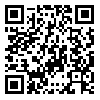Volume 6, Issue 1 (Spring & Summer 2020)
KJES 2020, 6(1): 41-54 |
Back to browse issues page
Download citation:
BibTeX | RIS | EndNote | Medlars | ProCite | Reference Manager | RefWorks
Send citation to:



BibTeX | RIS | EndNote | Medlars | ProCite | Reference Manager | RefWorks
Send citation to:
Barati M A, Yassaghi A, Madanipour S. Post Cretaceous Tectonic Evolution of Azadkuh Region in Central Alborz Mountains. KJES 2020; 6 (1) :41-54
URL: http://gnf.khu.ac.ir/article-1-2716-en.html
URL: http://gnf.khu.ac.ir/article-1-2716-en.html
1- , yassaghi@modares.ac.ir
Abstract: (1810 Views)
Azadkuh region located in Central Alborz Range and comprises Paleozoic to Cenozoic rock units. The Azadkoh Fault in the north and the TF4 Fault in the south bounded the region. This study aimed to investigate structural events in the region as a part of central Alborz since Cretaceous. Investigation of structural evidence shows several geological events in Cenozoic at this part of Central Alborz range. Cretaceous volcanic overlay the Triasic-Jurasic Shemshak Formation as angular unconformity. In addition, the Paleocene Fajan conglomerate as angular unconformity overlay the Cretaceous volcanic or older rocks. The presence of Cretaceous rocks and the Karaj Formation within the Eocene basin bounding faults in which syn-sedimentary faults developed demonstrate that the faults formed as normal kinematic acting as the basin bounding faults. Several evidence including high dip angle of the Azadkuh Fault, development of the TF3 Fault as the Azadkuh Fault backthrust in the fault hanging wall, thrust of the younger Cretaceous rocks over the older Triassic-Jurassic rocks, and formation of a pop-up structure in between the Azadkuh and TF3 faults might reflect the inverted normal nature for the faults. During Plio-Quaternary SW-ward movement of the Khazar Block with respect to Central Iran causes transpression tectonics in the region resulted in development of strike-slip faults and related structures that cross-cut the Azadkuh region inverted basin bounding faults.
Subject:
Tectonics
Received: 2019/10/13 | Accepted: 2020/08/31 | Published: 2020/08/31
Received: 2019/10/13 | Accepted: 2020/08/31 | Published: 2020/08/31
Send email to the article author
| Rights and permissions | |
 |
This work is licensed under a Creative Commons Attribution-NonCommercial 4.0 International License. |






